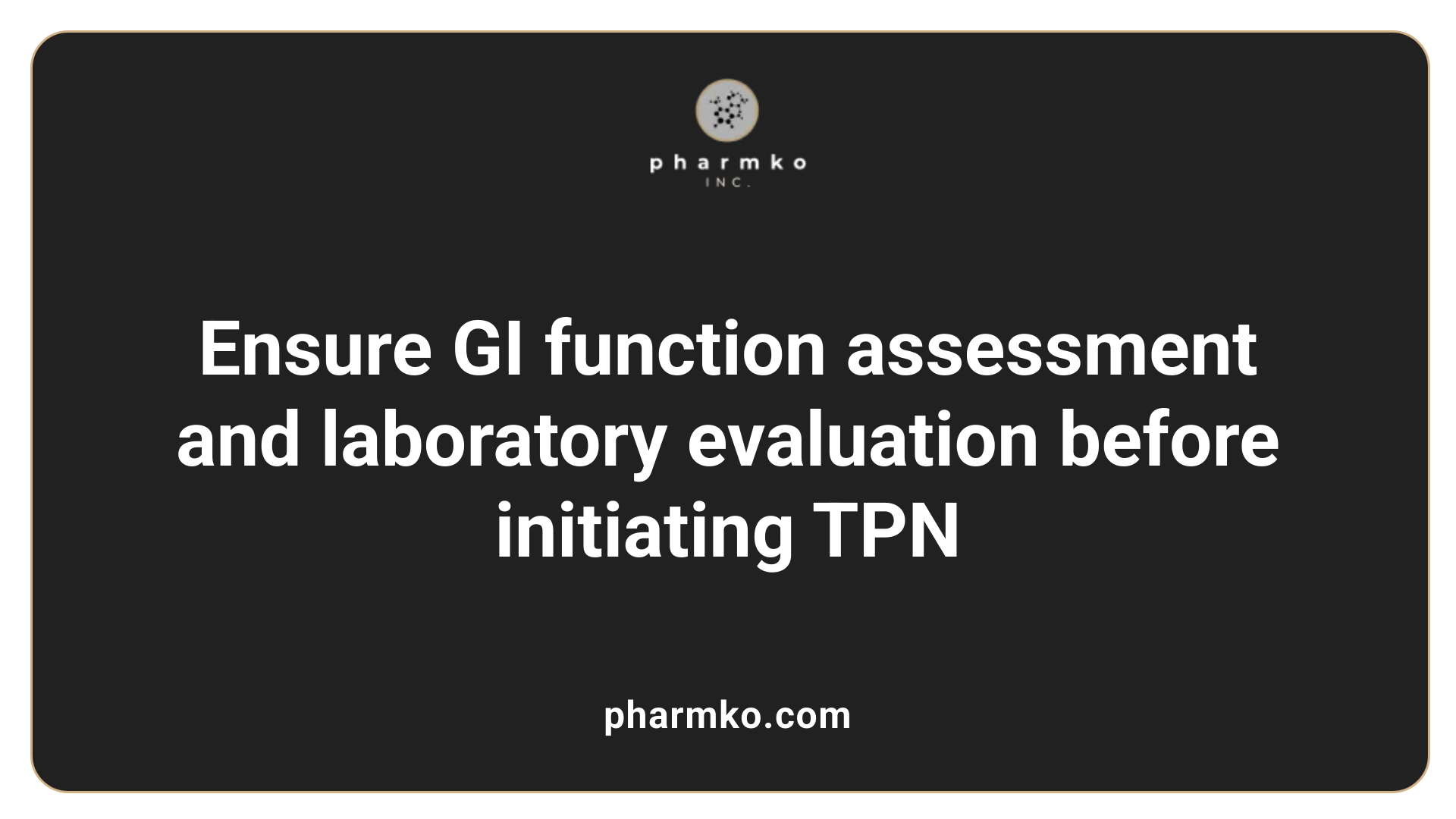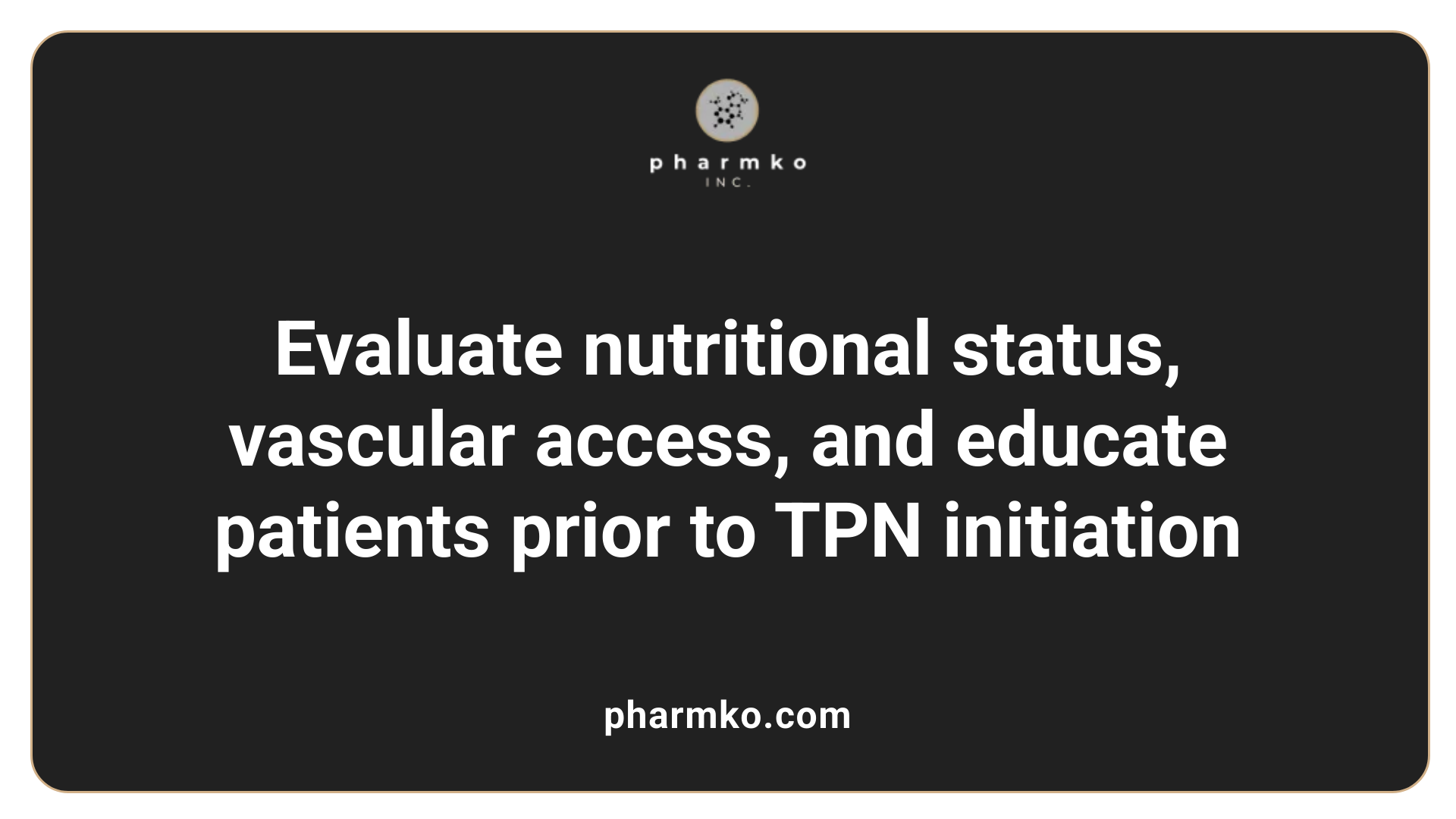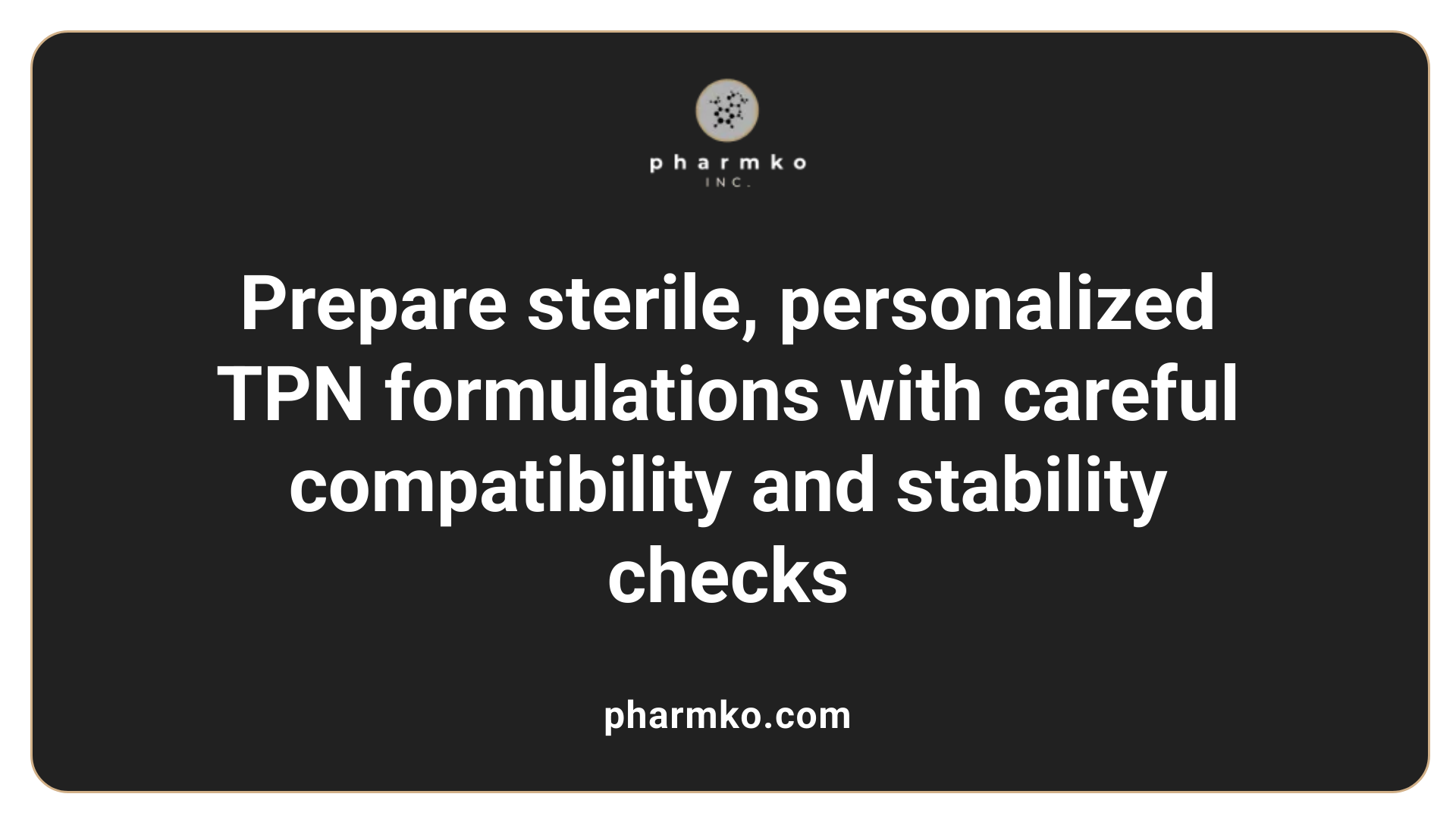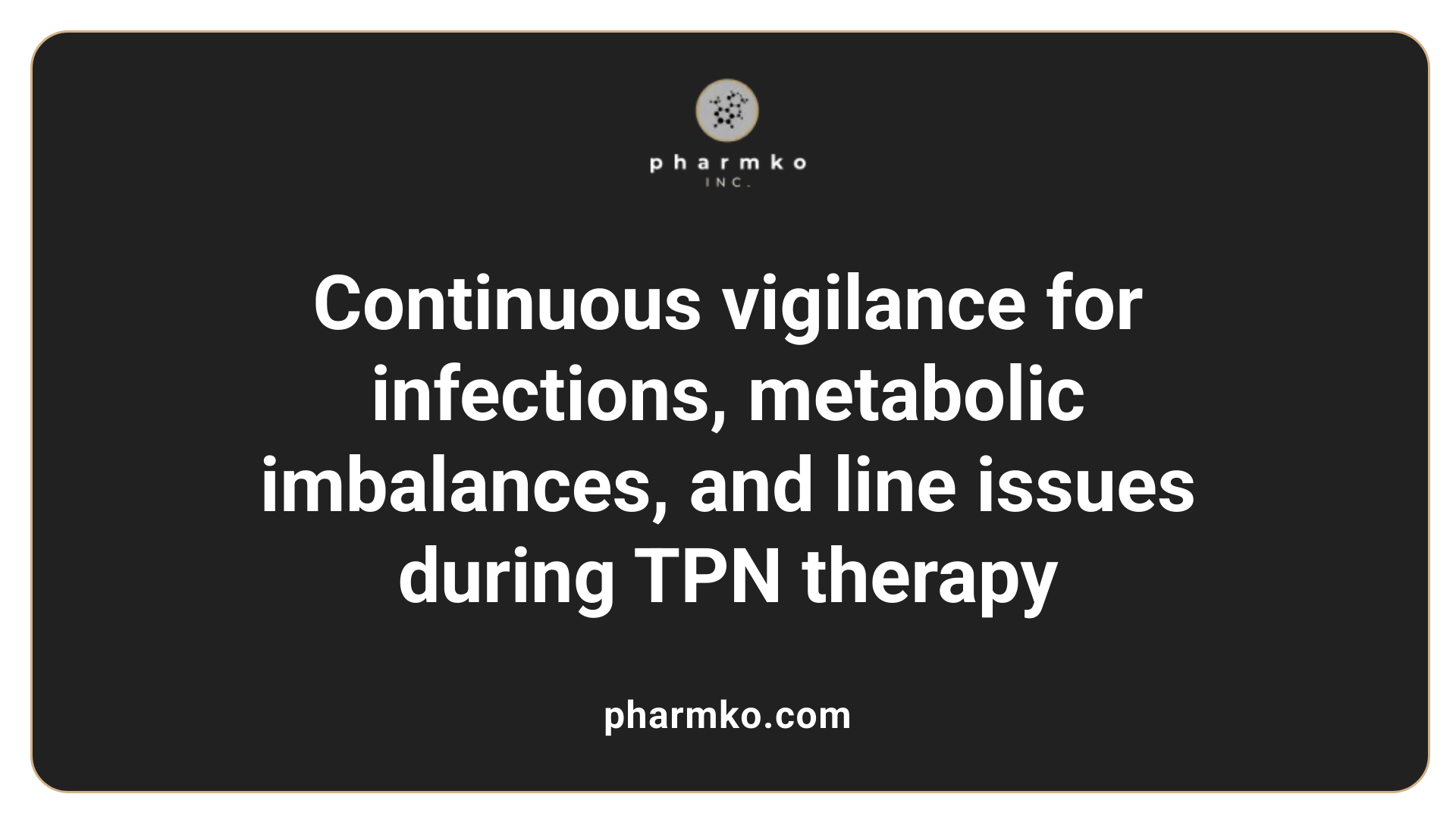How to Prepare for Starting Total Parenteral Nutrition
Understanding the Foundations of Total Parenteral Nutrition (TPN) Preparation
Starting TPN involves a thorough preparatory process that ensures patient safety, nutritional adequacy, and management of potential risks. This comprehensive guide explores the critical steps, assessment protocols, formulation design, safety measures, and monitoring strategies essential for effective TPN initiation.
Indications and Preconditions for Starting TPN

What are the indications and preconditions for starting total parenteral nutrition (TPN)?
Total parenteral nutrition (TPN) is a vital intervention for patients who cannot meet their nutritional requirements through the usual oral or enteral (tube feeding) routes. It is primarily indicated when gastrointestinal (GI) function is severely impaired or when other routes are contraindicated.
Common conditions that necessitate TPN include bowel obstruction, bowel pseudo-obstruction, GI fistulas with high output, and cases where the GI system is immature or malformed—such as in infants with congenital malformations. TPN is also essential in severe trauma, hypercatabolic states like sepsis, extensive burns, or after major surgeries where the digestive system needs to rest.
In situations where enteral nutrition cannot adequately meet the patient's metabolic needs—especially if the patient is malnourished or expected to be NPO (nothing by mouth) for more than seven days—TPN becomes a crucial alternative. It provides essential nutrients including proteins, carbohydrates, fats, vitamins, minerals, and trace elements directly into the bloodstream.
Initiation of TPN involves careful assessment of the patient’s nutritional status, gastrointestinal function, and overall clinical condition. It is contraindicated if the GI tract is functional and can provide sufficient nutrients, or if the patient’s condition is critically unstable without immediate therapeutic goals. Additionally, patients with good nutritional status and a short expected NPO duration (less than 7 days) may be managed without TPN initially.
Before starting TPN, healthcare providers must evaluate laboratory parameters such as electrolyte levels, liver and kidney function, and overall metabolic profile. Continuous monitoring during therapy is crucial to prevent complications like electrolyte imbalances, infections, or liver toxicity.
In summary, TPN is indicated in cases where the GI tract cannot be used effectively, the patient is malnourished or at risk of malnutrition, and when the anticipated support duration exceeds one week. Proper assessment and close monitoring are essential preconditions to ensure safe and effective nutritional therapy.
Pre-TPN Patient Assessment and Preparation

How should patients be assessed and prepared before starting TPN?
Prior to initiating Total Parenteral Nutrition (TPN), a thorough patient assessment is essential to ensure safety and effectiveness. This process begins with evaluating the patient’s overall nutritional status, which includes measuring body weight, BMI, and recent weight changes. Laboratory tests play a critical role; these typically involve checking serum electrolytes, renal and liver function, blood glucose levels, and blood counts. These tests help identify existing imbalances or organ dysfunction that could affect TPN administration.
A detailed review of the patient’s medical history is also vital. Conditions such as infections, metabolic disorders, or cardiovascular instability need to be accounted for. Contraindications like inadequate vascular access or a nonfunctioning gastrointestinal system must be identified to determine if TPN is appropriate.
The vascular access site requires careful evaluation. Proper placement of the central venous catheter—usually via the internal jugular, subclavian, or PICC line—is critical for safe infusion. The healthcare team should assess for potential risks like thrombosis or infection at the insertion site.
In addition to physical assessment, patient and caregiver education are foundational. They should be trained in sterile techniques for handling supplies, recognizing signs of complications (such as infection or catheter issues), and performing basic line care.
Planning the TPN formulation involves collaboration among healthcare professionals, including dietitians and pharmacists. Once the patient's specific needs are understood and risks are minimized, a tailored nutrient mixture is prepared, stored properly, and ready for safe administration.
This comprehensive preparation aims to reduce risks, improve tolerance, and ensure that TPN delivers the intended nutritional support effectively.
Formulation Design and Compounding of TPN Solutions
 The preparation of Total Parenteral Nutrition (TPN) solutions involves meticulous formulation and sterile compounding processes tailored to individual patient needs. TPN solutions typically comprise three primary macronutrients—dextrose (glucose), amino acids (protein precursors), and lipid emulsions—each providing essential calories and nutrition. Micronutrients such as vitamins, electrolytes, minerals, and trace elements are added to support metabolic functions and correct specific deficiencies.
The preparation of Total Parenteral Nutrition (TPN) solutions involves meticulous formulation and sterile compounding processes tailored to individual patient needs. TPN solutions typically comprise three primary macronutrients—dextrose (glucose), amino acids (protein precursors), and lipid emulsions—each providing essential calories and nutrition. Micronutrients such as vitamins, electrolytes, minerals, and trace elements are added to support metabolic functions and correct specific deficiencies.
To formulate a TPN, healthcare professionals calculate the required amounts of each component based on patient-specific parameters like age, weight, clinical condition, and laboratory values. These calculations ensure balanced ratios that meet caloric, protein, and micronutrient needs while avoiding complications like overfeeding or electrolyte imbalances.
During compounding, strict sterile techniques are employed to prevent microbial contamination. The components are dissolved and mixed in a sterile environment, often using automated compounding devices that enhance precision and reduce human error. Compatibility testing is crucial, particularly when combining components into a 3-in-1 admixture, which includes amino acids, dextrose, and lipids in a single bag. Compatibility considerations include preventing phase separation, emulsion breakdown, and interactions that could destabilize the mixture.
Stability and compatibility are assessed by consulting stability data and guidelines from manufacturers and professional organizations. The final mixture must be isotonic to minimize irritation and compatible with the central venous catheter. Adjustments may be needed over time based on ongoing laboratory monitoring such as electrolytes, liver function, and blood glucose levels.
In addition to precise formulation, proper storage—typically refrigerated and brought to room temperature before infusion—is vital to maintain stability. The sterile preparation process involves disinfecting vial tops, using sterile syringes for additive medications or vitamins, and ensuring all equipment is sterile. Once compounded, the TPN solution is labeled correctly with patient details, preparation date, and expiry time, then stored under specified conditions until administration.
This rigorous process in formulation and compounding aims to deliver a safe, effective nutritional therapy that meets individual patient needs while minimizing risks such as infection, instability, or adverse reactions. Regular monitoring during infusion and adjustments ensure ongoing safety and nutritional adequacy.
Monitoring and Managing Potential Complications

What are common complications of TPN and how can they be managed?
Total parenteral nutrition (TPN) is a valuable therapy for patients unable to meet their nutritional needs through oral or enteral routes. However, it carries potential risks and complications that require vigilant monitoring and management.
One of the most significant concerns is infections, especially catheter-related bloodstream infections (CRBSI). Maintaining strict sterile techniques during line insertion and care, along with regular line maintenance—such as dressing changes and flushing with sterile saline—are crucial in prevention. Any signs of redness, swelling, fever, or chills should prompt immediate evaluation.
Metabolic disturbances are also common with TPN. Hyperglycemia occurs if glucose infusion rates exceed the patient’s utilization; thus, blood glucose levels should be checked frequently, and insulin therapy adjusted as needed. Conversely, hypoglycemia can happen if TPN is stopped abruptly without proper tapering or transition, so gradual weaning is recommended.
Electrolyte imbalances, including abnormal sodium, potassium, magnesium, and phosphorus levels, must be closely monitored via laboratory tests. Correcting these imbalances involves adjusting the electrolyte content in the TPN formula and addressing underlying issues such as renal function or ongoing fluid losses.
Liver dysfunction, notably cholestasis and fatty liver, may develop with long-term TPN use. These conditions can be minimized by cycling TPN and avoiding overfeeding, particularly with excess lipids.
Line complications like thrombosis, line occlusion, or pneumothorax require prompt intervention. Ensuring proper line placement, regular assessment of line function, and immediate response to any line troubles are critical. Proper line flushing, adherence to aseptic technique, and routine imaging can help detect issues early.
A comprehensive approach involving a multidisciplinary team ensures early detection and management of these complications. Regular laboratory assessments—including blood glucose, electrolytes, liver enzymes, triglycerides, and markers of nutrient status—help guide therapy adjustments.
In summary, diligent monitoring, adherence to sterile procedures, and individualized management protocols are essential in preventing and controlling TPN-related complications, ultimately improving patient safety and outcomes.
Safety Protocols and Best Practices During TPN Setup and Administration
What safety protocols and best practices should be followed during TPN setup and administration?
Administering Total Parenteral Nutrition (TPN) requires meticulous attention to safety measures to prevent complications such as infections, line issues, and nutrient imbalances. The cornerstone of safe practice is strict aseptic technique. Healthcare providers should thoroughly disinfect their hands and all preparation surfaces before handling TPN components. When preparing the solution, sterilized equipment must be used in a clean environment that is free of dust, pets, and unnecessary traffic.
The preparation process involves checking the TPN bag for correctness, including verifying the label, expiration date, and appearance—look for leaks, cloudiness, or floating particles. Additives like medications or vitamins are added under sterile conditions, with syringes disinfected using alcohol wipes, and ports on the bag are cleaned before injection.
Line care and securement are crucial to prevent dislodgement and infections. The central venous catheter (CVC) insertion site must be regularly inspected for redness, swelling, or signs of infection. Proper catheter securement techniques and dressing changes using sterile dressings help minimize line-related infections. Flushing protocols, usually with sterile saline, maintain line patency and prevent clots or blockages.
Using in-line filters, such as 1.2-micron filters, is recommended to trap particulates and prevent embolic events. It is vital to ensure medication compatibility with the TPN mixture to avoid precipitates and adverse reactions. Filters need regular checks and replacement if occluded or after 24 hours of use.
Proper storage and handling of TPN are essential. The solution should be stored in a refrigerator at around 35°F (1.6°C), checked for leaks, and allowed to warm to room temperature before infusion. During infusion, TPN should be administered with an infusion pump set to the prescribed rate, with continuous monitoring of the patient’s blood glucose, electrolytes, and signs of infection or line complication.
In summary, adherence to aseptic techniques, diligent line care, appropriate filter use, medication compatibility checks, and proper storage are all vital practices that support safe and effective TPN therapy. Regular training, documentation, and awareness of emergency protocols further enhance patient safety during TPN administration.
Procedures and Equipment for TPN Preparation and Administration
What procedures and equipment are involved in the preparation and administration of TPN?
The preparation of Total Parenteral Nutrition (TPN) is a meticulous process carried out by pharmacy staff to ensure safety and efficacy. It begins with calculating the precise caloric and nutrient requirements for the patient, which involves a detailed assessment of clinical needs, often using formulas or indirect calorimetry.
Once calculations are complete, the actual preparation involves sterile compounding techniques. Pharmacy personnel set up a clean, disinfected environment, thoroughly wash hands, and use sterile gloves, equipment, and solutions. They first verify the ingredients, labels, expiration dates, and check for leaks or cloudiness.
The amino acid/dextrose solutions and lipid emulsions are then mixed under strict aseptic conditions. These mixtures are typically prepared in large or small bags, depending on the components added. Any medications, vitamins, or electrolytes are added in a sterile manner, using syringes and following protocols to prevent contamination.
Before administration, these solutions are checked visually for clarity, proper mixing, and absence of particles.
Equipment used during preparation includes sterile syringes, IV filters, and infusion pumps. The TPN solution is stored in a refrigerator at 35°F (1.6°C) and brought to room temperature before use.
For administration, a central venous catheter (CVC)—placed via subclavian, jugular, or PICC line—is employed due to the hyperosmolar nature of TPN. Proper insertion and maintenance of the catheter are critical to prevent infections.
The sterile TPN is connected to the patient through an infusion set attached to the CVC. An infusion pump, often a Curlin pump, regulates the flow rate, which can be continuous or cycled over specific hours.
Monitoring during administration includes checking blood glucose, electrolytes, liver and kidney function, and observing for signs of complications like infection or catheter issues. Proper aseptic technique throughout the process of preparation, connection, and infusion is vital to ensure patient safety and prevent infections.
In summary, TPN preparation and administration require precise calculations, sterile compounding, proper equipment, and vigilant monitoring to deliver nutrients safely and effectively.
Routine Infusion Management of TPN
What is the typical routine for TPN infusion?
The routine for administering Total Parenteral Nutrition (TPN) is meticulous and follows strict sterile procedures to ensure patient safety and treatment efficacy. Initially, preparation involves verifying the correct composition of the TPN solution—checking labels, expiration dates, and infection control essentials such as sterile gloves and disinfected workspaces.
Once prepared, the infusion setup is aseptically connected. This includes attaching the TPN bag to an infusion set and ensuring the connection is secure. Prior to starting the pump, the central venous catheter (CVC) is flushed with sterile saline to clear any residual blood or medication, reducing the risk of clotting or infection.
In a hospital setting, TPN is typically administered continuously over 24 hours using an infusion pump, such as a Curlin pump. The pump is programmed to deliver the appropriate rate according to the patient’s prescribed nutritional needs, which are individualized based on their health status. Careful attention is paid to the initial infusion rate, usually starting at no more than 50% of the target, and then gradually increased (permissive underfeeding) to prevent metabolic complications.
Continuous monitoring during infusion is essential. Healthcare providers check serum electrolytes, blood glucose levels, and vital signs regularly to detect any early signs of metabolic imbalance, such as hyperglycemia or electrolyte disturbances. They also observe the site for signs of infection or catheter-related issues.
For home care, TPN is often administered in a cycling manner, typically over 12 to 16 hours per day, aligning with the patient’s lifestyle and metabolic needs. Patients or caregivers are trained extensively in aseptic techniques, pump operation, and recognizing complications.
Once the infusion is complete, the line must be carefully flushed with sterile saline to maintain catheter patency. Disposal of used supplies follows strict infection control protocols to prevent any contamination.
This routine process underscores the importance of precision, sterile technique, and ongoing assessment to mitigate risks such as infection, metabolic derangements, and catheter complications, ensuring effective nutritional support for the patient.
Educational Points for Proper TPN Management
Managing total parenteral nutrition (TPN) effectively requires thorough education for both healthcare providers and caregivers. Key lessons include proper preparation and aseptic techniques to prevent infections. This involves meticulous hand hygiene, disinfecting vials and ports, and ensuring sterile procedures during mixing and administration.
Training should emphasize the correct handling of equipment such as infusion pumps, central venous catheters, and sterile supplies. Users must learn how to program pumps accurately, troubleshoot common alarms, and perform routine maintenance like flushing lines with saline and heparin.
Monitoring for adverse reactions is crucial. Caregivers and providers should be vigilant for signs of infection, such as redness, swelling at the insertion site, fever, or chills. Recognizing symptoms of metabolic disturbances, like hyperglycemia and electrolyte imbalances, allows prompt intervention.
Proper storage of TPN solutions is essential; bags should be refrigerated, checked for expiration, leaks, and cloudiness before use. When adding medications or vitamins, clinicians should follow sterile protocols, ensuring compatibility and stability.
Signs of complications such as access site infections, metabolic issues, or pump failures necessitate immediate medical attention. Routine blood tests for electrolytes, blood glucose, and organ function guide adjustments in the TPN formula.
Educating patients and caregivers also involves teaching catheter care to prevent infections, proper infusion procedures, and how to safely disconnect and dispose of supplies. This education maximizes safety, minimizes risks, and supports effective nutritional therapy.
Overall, adherence to these educational points ensures a safe, effective TPN process that meets individual patient needs and reduces potential complications.
Key Takeaways for Safe and Effective TPN Initiation
Proper preparation, assessment, sterile technique, and ongoing monitoring are fundamental to the successful initiation and management of TPN. Adhering to safety protocols, customizing formulations, and educating both healthcare providers and patients help minimize risks and enhance outcomes, ultimately supporting the patient’s nutritional and clinical needs effectively.
References
- Total Parenteral Nutrition - StatPearls - NCBI Bookshelf
- When and how to start parenteral nutrition - Deranged Physiology
- Home Total Parenteral Nutrition (TPN)
- What To Expect When Starting Total Parenteral Nutrition (TPN)
- [PDF] Total Parenteral Nutrition: Home Care Guide - Northwestern Medicine
- [PDF] The Hitchhiker's Guide to Parenteral Nutrition Management for Adult ...
- [PDF] Strategies for Successful Parenteral Nutrition Order Writing - ASHP
- 8.8 Total Parenteral Nutrition (TPN) – Clinical Procedures for Safer ...
- Discharge Instructions: Total Parenteral Nutrition (TPN) for Your Child
- Parenteral Nutrition: What it Is, Uses & Types - Cleveland Clinic













